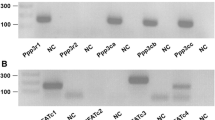Abstract
Objective
To study, at the cytological level, the basic concept of Chinese medicine that “the Kidney (Shen) controls the bone”.
Methods
Kaempferol was isolated form Rhizoma Drynariae (Gu Sui Bu, GSB) and at several concentrations was incubated with opossum kidney (OK) cells, osteoblasts (MC3T3 E1) and human fibroblasts (HF) at cell concentrations of 2×104/mL. Opossum kidney cell-conditioned culture media with kaempferol at 70 nmol/L (70kaeOKM) and without kaempferol (0OKM) were used to stimulate MC3T3 E1 and HF proliferation. The bone morphological protein receptors I and II (BMPR I and II) in OK cells were identified by immune-fluorescence staining and Western blot analysis.
Results
Kaempferol was found to increase OK cell growth (P<0.05), but alone did not promote MC3T3 E1 or HF cell proliferation. However, although OKM by itself increased MC3T3 E1 growth by 198% (P<0.01), the 70kaeOKM further increased the growth of these cells by an additional 127% (P<0.01). It indicates that the kidney cell generates a previously unknown osteoblast growth factor (OGF) and kaempferol increases kidney cell secretion of OGF. Neither of these media had any significant effect on HF growth. Kaempferol also was found to increase the level of the BMPR II in OK cells.
Conclusions
This lends strong support to the original idea that the Kidney has a significant influence over bone-formation, as suggested by some long-standing Chinese medical beliefs, kaempferol may also serve to stimulate kidney repair and indirectly stimulate bone formation.
Similar content being viewed by others
References
Flaws B, Sionneau P, eds. The treatment of modern Western medical disease with Chinese medicine. A textbook and clinical manual. North Boulder: Blue Poppy Press; 2001:9.
Malluche HH, Mawad HW, Monier-Faugere MC. Renal osteodystrophy in the first decade of the new millennium: analysis of 630 bone biopsies in black and white patients. J Bone Miner Res 2011;26:1368–1376.
Gal-Moscovici A, Sprague SM. Use of vitamin D in chronic kidney disease patients. Kidney Int 2011;8:146–151.
Hamdy NA. Calcium and bone metabolism pre- and postkidney transplantation. Endocrinol Metab Clin North Am 2007;36:923–935.
DeLuca HF. Overview of general physiologic features and functions of vitamin D. Am J Clin Nutr 2004;80(Suppl):1689S–1696S.
Groeneveld EHJ, Burger EH. Bone morphogenetic proteins in human bone regeneration. Eur J Endocrinol 2000;142:9–21.
Chen D, Zhao M, Mundy GR. Bone morphogenetic proteins. Growth Factors 2004;22:233–241.
Kitten AM, Kreisber JI, Olson MS. Expression of osteogenic protein-1 mRNA in cultured kidney cells. J Cell Physiol 1999;181:410–415.
Bramlage CP, Tampe B, Koziolek M, Maatouk I, Bevanda J, Bramlage P, et al. Bone morphogenetic protein (BMP)-7 expression is decreased in human hypertensive nephrosclerosis. BMC Nephrol 2010;16:11:31.
Morrissey J, Hruska K, Guo G, Wang S, Chen Q, Klahr S. Bone morphogenetic protein-7 improves renal fibrosis and accelerates the return of renal function. J Am Soc Nephrol 2002;13:S14–S21.
Lund RJ, Davies MR, Brown AJ, Hruska KA. Successful treatment of an adynamic bone disorder with bone morphogenetic protein-7 in a renal ablation model. J Am Soc Nephrol 2004;15:359–369.
Lissenberg-Thunnissen SN, de Gorter DJ, Sier CF, Schipper IB. Use and efficacy of bone morphogenetic proteins in fracture healing. Int Orthop 2011;35:1271–1280.
Anborgh PH, Mutrie JC, Tuck AB, Chambers AF. Role of the metastasis-promoting protein osteopontin in the tumour microenvironment. J Cell Mol Med 2010;14:2037–2044.
Nagai Y, Watanabe M, Ishikawa S, Karashima R, Kurashige J, Iwagami S, et al. Clinical significance of Wnt-induced secreted protein-1 (WISP-1/CCN4) in esophageal squamous cell carcinoma. Anticancer Res 2011;31:991–997.
Ding J, List EO, Bower BD, Kopchick JJ. Differential effects of growth hormone versus insulin-like growth factor-1 on the mouse plasma proteome. Endocrinology 2011;152:3791–3802.
Dimitriou R, Jones E, McGonagle D, Giannoudis PV. Bone regeneration: current concepts and future directions. BMC Me 2011;31:9:66.
Bensky D, Clavey S, Stoger E, eds. Chinese herbal medicine materia medica. 3rd ed. Seattle: Eastland Press; 798–800.
Long M, Qiu D, Li F, Johnson F, Luft B. Flavonoid of Drynaria fortunei protects against acute renal failure. Phytother Res 2005;19:422–427.
Wong RW, Rabie AB. Systemic effect of crude extract from rhizome of Drynaria fortunei on bone formation in mice. Phytother Res 2006;20:313–315.
Nirmala P, Ramanathan M. Effect of kaempferol on lipid peroxidation and antioxidant status in 1,2-dimethyl hydrazine induced colorectal carcinoma in rats. Eur J Pharmacol 2011;654:75–79.
da-Silva WS, Harney JW, Kim BW, Li J, Bianco SD, Crescenzi A, et al. The small polyphenolic molecule kaempferol increases cellular energy expenditure and thyroid hormone activation. Diabetes 2007;56:767–776.
Sommerfeldt DW, McLeod K, Rubin C, Hadjiargyrou M. Differential phosphorylation of paxillin in response to surfacebound serum proteins during early osteoblast adhesion. Biochem Biophys Res Commun 2001;285:355–363.
Li S X, Zhang Z G, Long M, Cai GX. HPLC fingerprint of ultramicro Rhizoma Drynariae. Chin Tradit Herb Drugs (Chin) 2005;36:1634–1637.
Long M, Smouha EE, Qiu D, Li F, Johnson F, Luft B. Flavanoid of Drynaria fortunei protects against gentamicin ototoxicity. Phytother Res 2004;18:609–614.
Wang ZY. Effect of Gu Sui Bu on the fracture recovery. Bull Bejing Univ Chin Tradit Med (Chin) 1980;3:13.
Servais H, Jossin Y, van Bambeke F, Tulkens PM, Mingeot-Leclercq MP. Gentamicin causes apoptosis at low concentrations in renal LLC-PK1 cells subjected to electroporation. Antimicrob Agents Chemother 2006;50:1213–1221.
Author information
Authors and Affiliations
Corresponding author
Rights and permissions
About this article
Cite this article
Long, M., Li, Sx., Xiao, Jf. et al. Kidney tubular-cell secretion of osteoblast growth factor is increased by kaempferol: A scientific basis for “The Kidney Controlling the Bone” theory of chinese medicine. Chin. J. Integr. Med. 20, 675–681 (2014). https://doi.org/10.1007/s11655-014-1336-z
Received:
Published:
Issue Date:
DOI: https://doi.org/10.1007/s11655-014-1336-z




